Disclaimer: This article may contain affiliate links. Clicking on them may earn Costa Rica Vibes a commission, at no extra cost to you. Thank you for your support!
Costa Rica Volcanoes – Visit Up Close
One of the most popular draws for tourists to Costa Rica is all of the amazing volcanoes. Costa Rica volcanoes exist all over the country. Some are dormant, but there are plenty of active ones as well. In fact, the country is home to five active volcanoes and over 50 dormant volcanoes.
Did you know that Costa Rica is part of the ring of fire? For those of you who have no idea what I’m talking about, no, I am not referencing the classic Johnny Cash song “Ring of Fire.”
The ring of fire is the name given to the ring-shaped area of land that runs along the Pacific coast. This area is home to 75% of the world’s volcanoes. That means that there are also a lot of earthquakes in Costa Rica due to this seismic activity. Fortunately, most of the earthquakes are very mild.
Active Volcanoes in Costa Rica
As I mentioned above, there are five active volcanoes in Costa Rica. All five volcanoes are considered Costa Rican national parks. Although they are active you are still able to visit four out of the five volcanoes. Let’s go through each one!
Poas Volcano – Alajuela
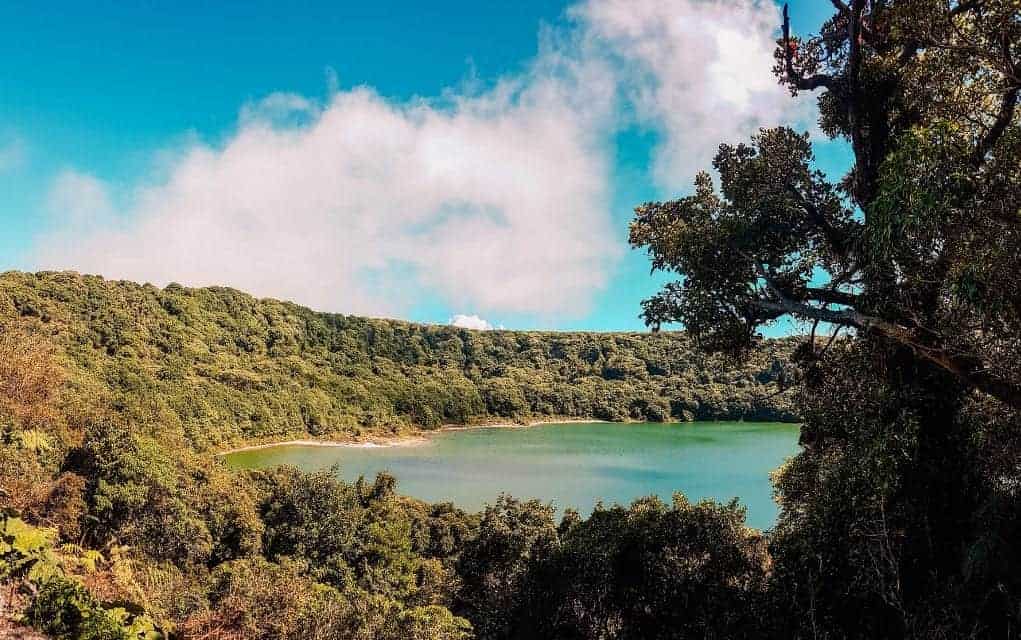
Poas Volcano is the most visited volcano in Costa Rica. On a clear day, this place is absolutely beautiful. We also love this place because it is located less than an hour away from the San Jose Airport in the beautiful Central Valley.
If you would like to see crater lakes, this is our top pick for that experience. As you can see in the picture above, the crater lake here is huge and amazing.
In recent years Poas has gone through a few somewhat major eruptions. Regulations are now much stricter for visitors. You do need to purchase your tickets ahead of time online. We suggest doing this via Viator, here. It is a few dollars more but it will save you so much hassle.
Check out our Complete Guide to Poas. This guide will walk you through the whole ticket purchasing process and give you plenty of other helpful tips including info on the best time of day and year to visit for a really clear view of the crater.
Irazu Volcano – Cartago
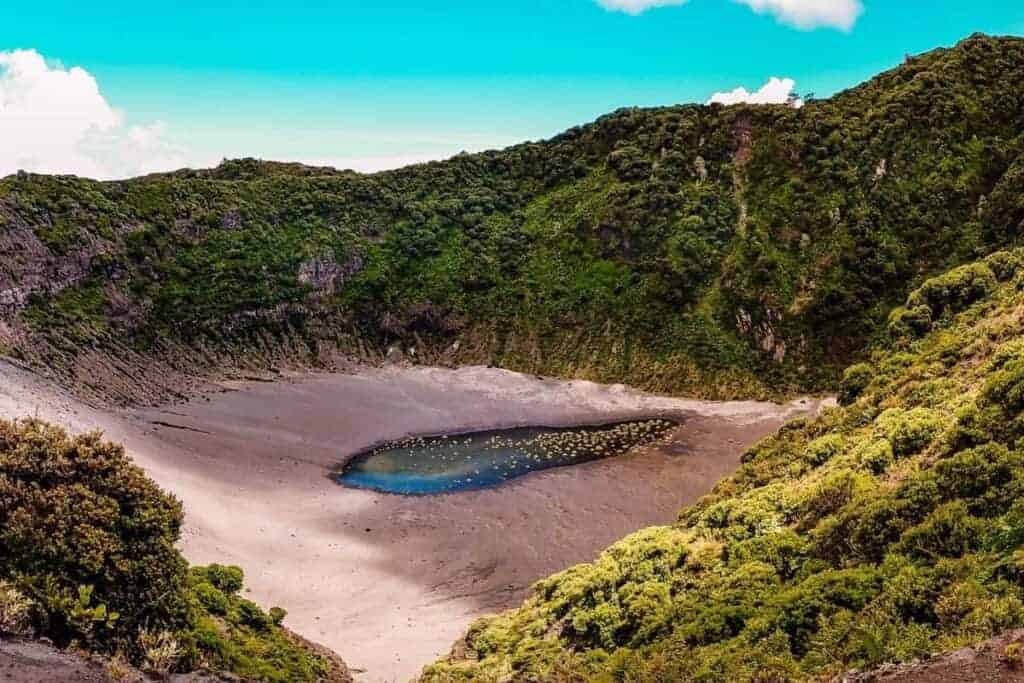
I really like Irazu volcano because as a visitor you can get very close to the crater. The crater is also located just next to the parking lot, so it is not a difficult walk at all.
Keep in mind that this is the highest point in all of Costa Rica. Be prepared to take things slow. The altitude can definitely get to you.
For more information on planning your visit, check out our Guide to Irazu Volcano. This guide also includes fun things that you can do in the nearby area after your volcano visit.
Rincon de La Vieja – Guanacaste
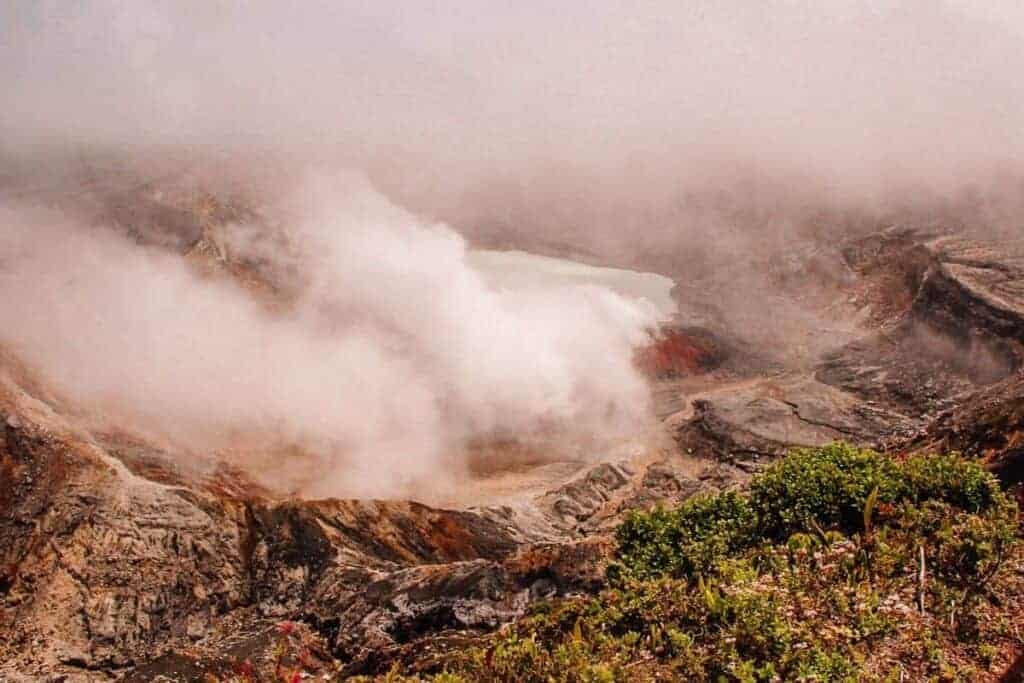
Rincon de la Vieja is located in the northwest part of the country near the Nicaragua border. If you are planning to fly in or out of Liberia airport this is only a short drive away.
This area is great for relaxing in hot springs, hiking, horseback riding, and more!
We have a complete guide to the area for more info.
Arenal Volcano – La Fortuna
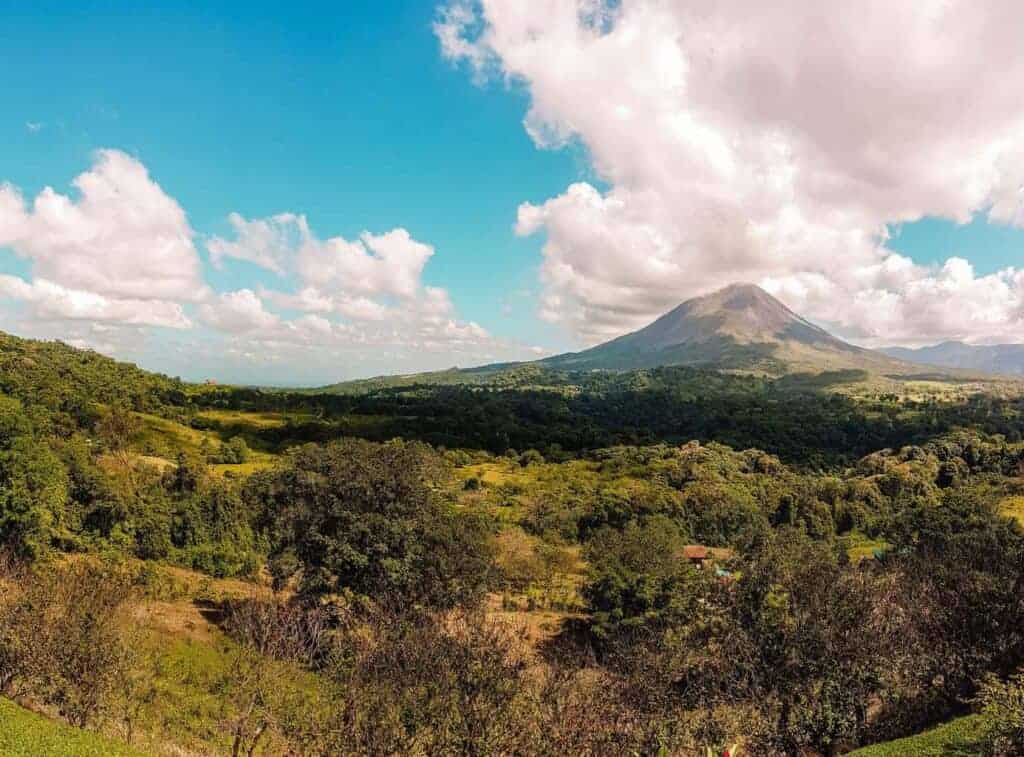
Arenal Volcano is the epitome of what you imagine when you think of a volcano. It is so cool to be driving in to La Fortuna and to look up and see this massive natural structure rising up in to the sky.
Arenal is an active volcano so it is not possible to hike to the top of it. However, there is an old lava field where you can see the path of the lava flows. This makes a great hike.
This trail is called the 1968 trail. You do not need a guide to visit but the walk does cost $15 per person. You can find out more on the official 1968 trail website.
Although the hike is nice, our favorite way to enjoy this volcano is from below. We like to visit the nearby hot springs with a picnic and just enjoy the view.
The best time of year to ensure a great view is during the dry season (January until April). We have visited a few times during rainy weather and haven’t been able to even see the volcano. You just never know how the weather will be during the rainy months.
We have a complete visitors guide to Arenal Volcano for more info.
Turrialba Volcano – Cartago
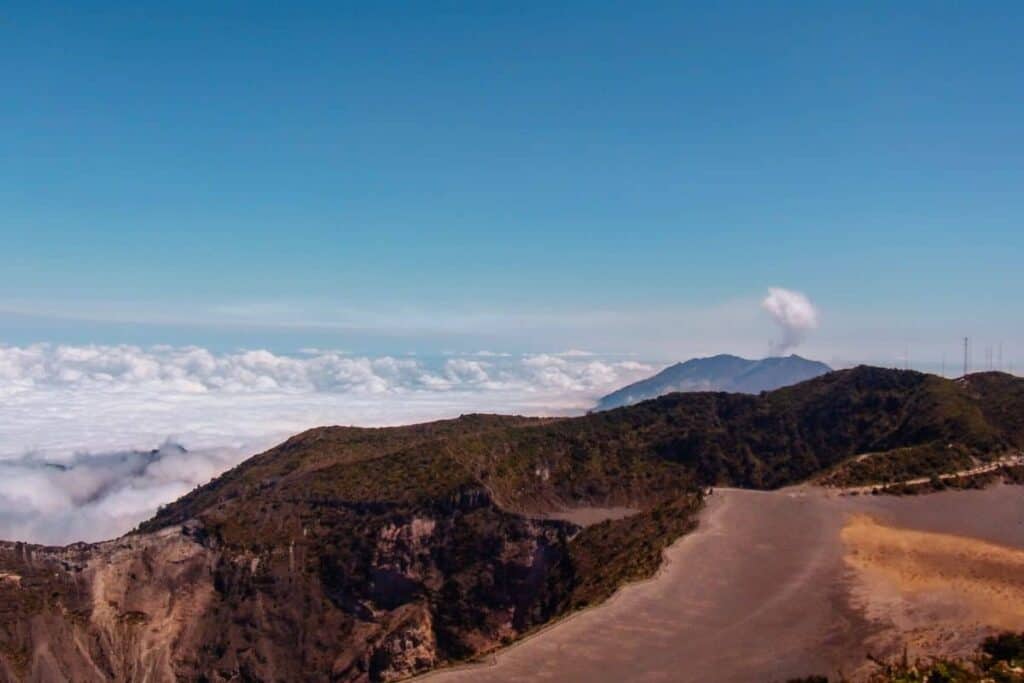
See that puff of smoke in the image above? That is the Turrialba volcano. On a clear day, you can see it erupting from the top of Irazu Volcano.
It is not currently possible to visit Turrialba volcano due to the constant eruptions. However, you can drive to the town of Turrialba and even to the entrance of the park. From here you can see the eruptions. Just be warned your clothes might get rather ashy and it is not good to breath close to the volcano for too long.
We live almost 50 miles away from Turrialba and we even have problems with ash. It is not fun when your floors have a constant layer of soot on them. It is probably not the best for us to constantly be breathing that in either.
Costa Rica Volcano Map
Here is a map of all the volcanoes in Costa Rica that we have mentioned above. This will give you a better idea of where exactly you have to go to visit each of these unique destinations.
Inactive Costa Rica Volcanoes
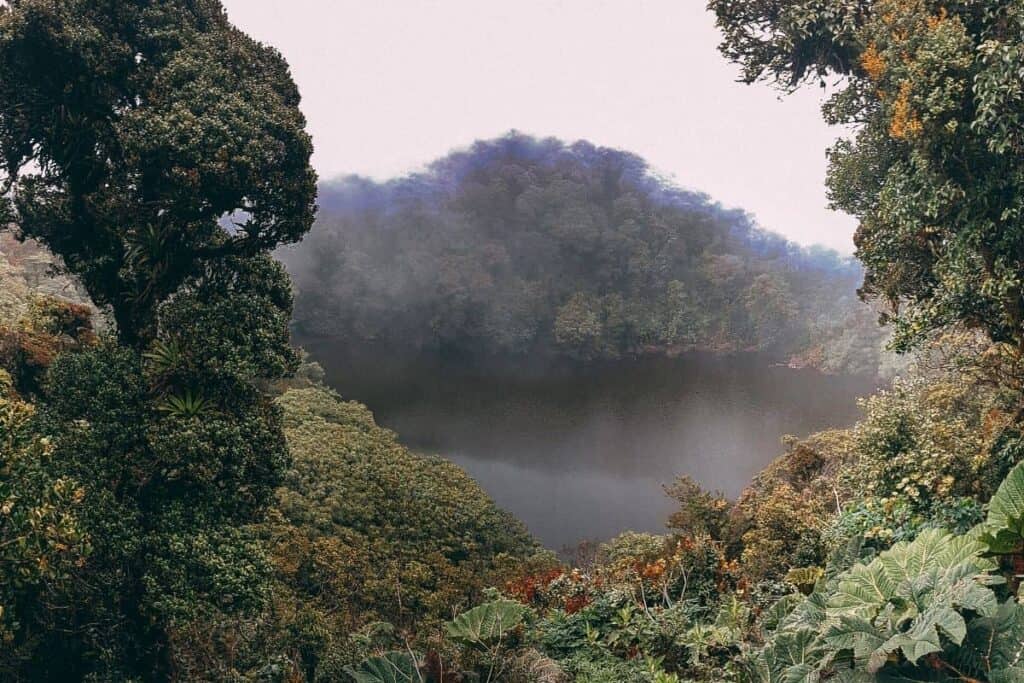
As I mentioned at the beginning of this article, there are over 50 dormant or extinct volcanoes in Costa Rica. Most of these are really small, but there are a few substantial ones which you can actually visit.
Barva Volcano – Heredia
Barva Volcano is a great place to hike. It is located about 45 minutes away from San Jose airport. We like hiking here because there is hardly ever anybody else around. It’s really peaceful.
For more volcano info, check out the Barva website. Just keep in mind that you will need a car with 4 wheel drive to get here.
↪FIND OUT HOW TO GET UP TO 10% OFF YOUR CAR RENTAL IN COSTA RICA!
Cero Chato Volcano – Near La Fortuna
This volcano is unfortunately not open for visitors as of 2017. Because it is located next to Arenal Volcano people were using it to climb up the back side of Arenal. The Costa Rican government had to close it to keep this from happening.
There is a fence blocking off this hike but I have heard of many tourists ignoring the closure and cutting through the fence to hike anyway.
I don’t recommend doing this for your own safety. If something happens while you are hiking it will be very difficult for any emergency services to get to you. Plus, there will likely be nobody else around to help you, but you can make your own choices on that. 🙂
Tenorio Volcano
Most people visit Tenorio National Park to enjoy the bright blue waters of Rio Celeste Waterfall. However, it is also possible to visit the volcano side of the national park as well.
I will warn you, the roads around here can be….interesting. I definitely suggest having a four-wheel drive vehicle. I once gave my dad the wrong directions and he drove around this area for several hours. I felt horrible, but he seemed to love it and described it as a scene from the Deliverance (doesn’t really sound fun to me, but whatever).
Anyway, you will need to hire a private guide if you wish to hike the volcano. Access is very limited.
Miravellas Volcano
This volcano is located between Tenorio Volcano and Rincon de La Vieja. This area is great for soaking in several different hot springs.
Costa Rica Volcano Safety
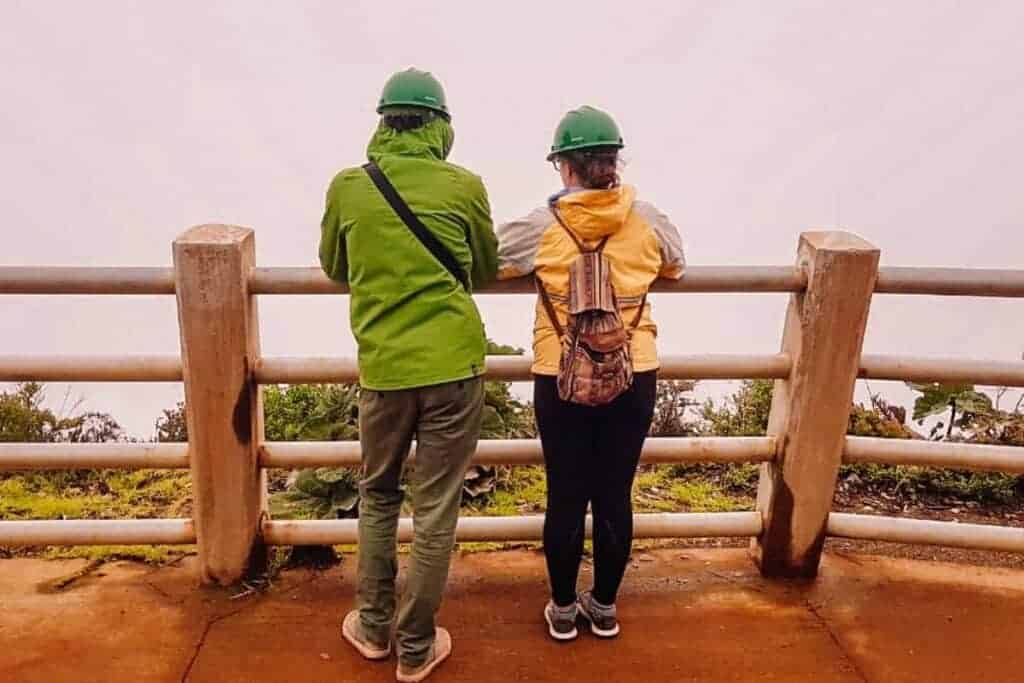
Although Costa Rican volcanoes are really fun to visit, you need to be careful. Your health and safety are obviously your top priority. Although Costa Rica does a great job of trying to post signs and enact safety measures, they are not always as thorough as you may be used to. Here are a few things to consider….
-Some of these volcanoes are really high in elevation. In fact, Irazu Volcano is 11,260 ft (3,432 meters) high. If you are at the top of any of these extremely high volcanoes you may find yourself getting out of breath very quickly.
It is best to walk slow and take frequent breaks. I always bring Gatorade (I swear it helps) and some granola bars to munch on to keep my energy level up.
If you really are not feeling well, head down the volcano immediately. Altitude sickness is no fun!
-Most parking attendants near the volcanoes will tell you to pull in to your parking space with the front of your car facing out. This will allow you to drive out of the area quickly in case of an eruption.
If the parking attendant does not mention this, it is best to do this anyway. It doesn’t hurt to have the knowledge that you can drive off quickly if needed.
-Costa Rica is great about monitoring volcanic activity and taking precautions when necessary.
For example, because Poas has been so active in recent years, guests now need to wear hard hats and go with a group to visit the crater. You are also only allowed to stand at the crater for about twenty minutes. This time limit is to keep you from breathing in the gasses for two long.
My point is, maybe the rules seem dumb sometimes but they are all in place for your safety.
Alright, that’s all we’ve got for you on Costa Rica volcanoes. If you have any questions please feel free to leave them in the comment section below and we will get back to you as soon as possible. Also, if you have any other tips for fellow travelers we would love to hear them.
You Might Also Like:
Costa Rica Travel Details: What You Need to Know
🚗 Should I rent a car in Costa Rica?
Having a rental car will give you the most flexibility when traveling in Costa Rica. This will also allow you to take fun day trips on your own.
- Save 10% Plus Other Perks with Our Adobe Rental Car Discount
- You might also consider; shared shuttle services or private transfer services
🏄🏽 How can I book things to do?
We find that Viator tends to have the most comprehensive selection of activities with secure booking and good cancellation policies.
🍍 I’m overwhelmed with planning. Can you help?
Of course! I suggest joining our Facebook group for specific questions and head to our Start Here Page to get started planning.
✈️ What is the best way to book a flight?
Usually, we have the best luck finding great prices with Skyscanner. Check for flights to both San Jose Airport (SJO) and Liberia Airport (LIR).
🛏️ What is the best way to book my Costa Rica hotels?
We highly suggest Booking.com for hotel bookings and typically use VRBO for Costa Rica vacation rentals.
🗣️What is the main language in Costa Rica?
The main language in Costa Rica is Spanish. Most people working in tourism speak at least some English.
💰 What is the currency in Costa Rica?
The currency used in Costa Rica is the Costa Rican colón (CRC). However, the US dollar is widely accepted in most tourist areas
📞 What is the best way to stay connected?
An eSIM from Airalo is the easiest way to get 4G data while traveling in Costa Rica.
🌴 Is Costa Rica safe?
Generally, Costa Rica is considered safe for tourists. However, like any travel destination, it’s best to use caution and be aware of your surroundings.
🛂 Do you need a passport to go to Costa Rica?
Yes, Costa Rica is its own country. You will need a passport to visit.

Hi! We’re Thomas (the German) and Sarah (the US-er)
We met in Virginia, moved to Germany, and since 2016 we have lived in sunny Costa Rica.
It was a spontaneous decision to move here, but it was the best decision!
Now we spend our days roaming the country to bring you the very best in Costa Rica travel here on Costa Rica Vibes.
Sarah is the writer. Thomas is the one keeping it all together.
Want the whole crazy story?

Sarah McArthur
Sarah McArthur is the co-founder and main writer of Costa Rica Vibes.
She is originally from the United States but has lived in sunny San Jose, Costa Rica since 2016.
She has traveled all over the country and now considers herself a self-proclaimed Costa Rica travel expert.
Want the whole crazy story?

